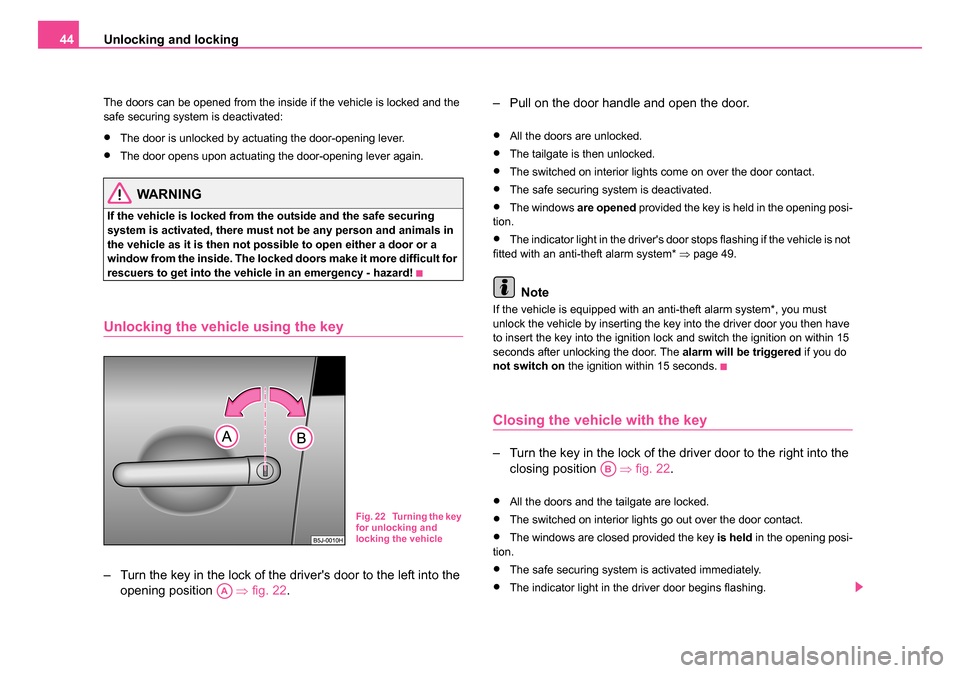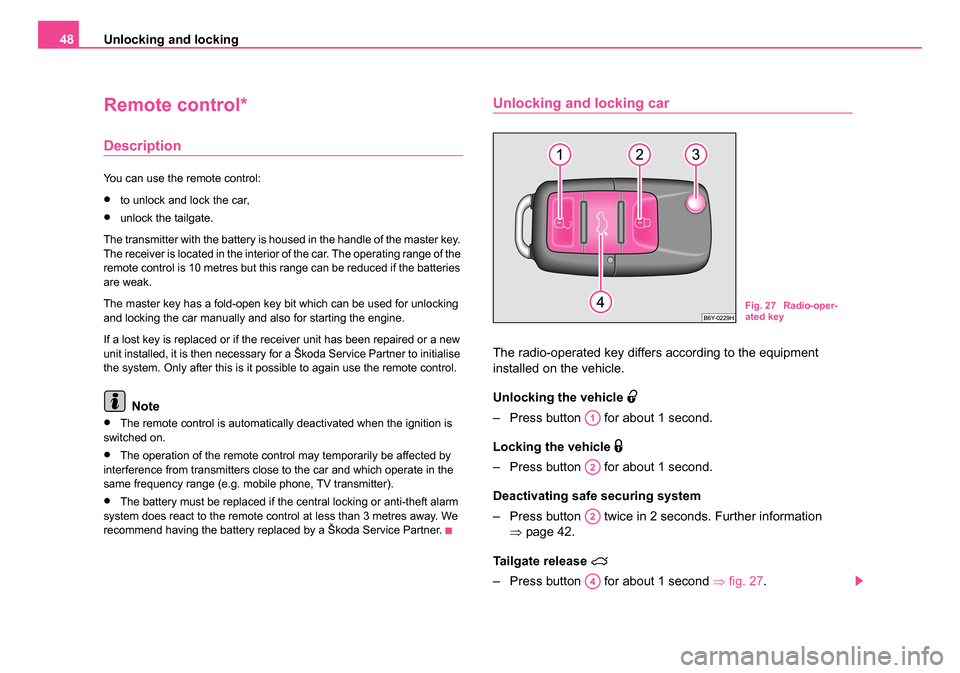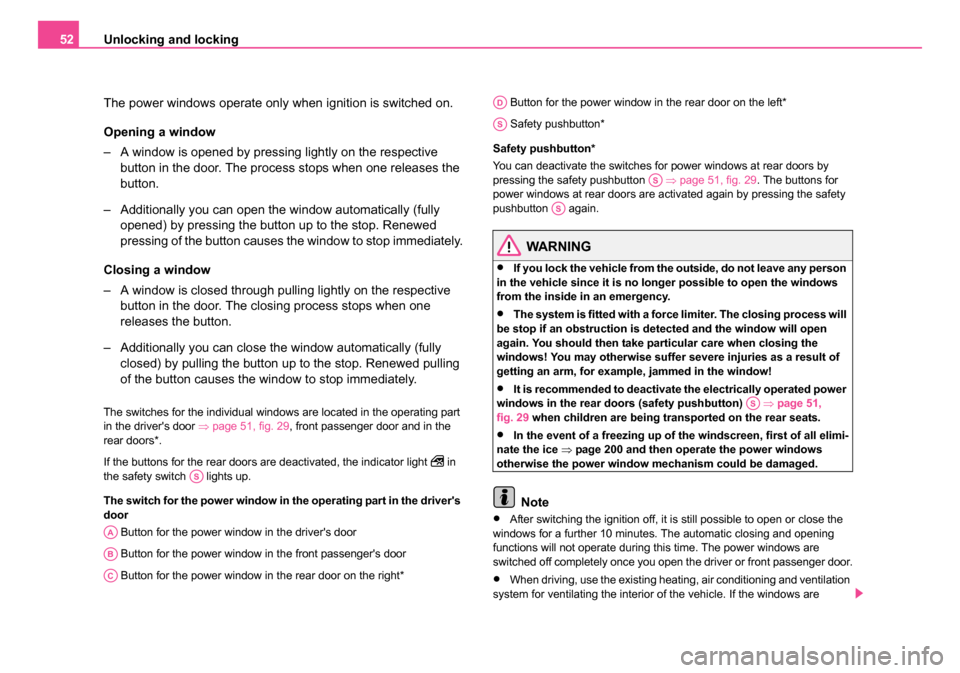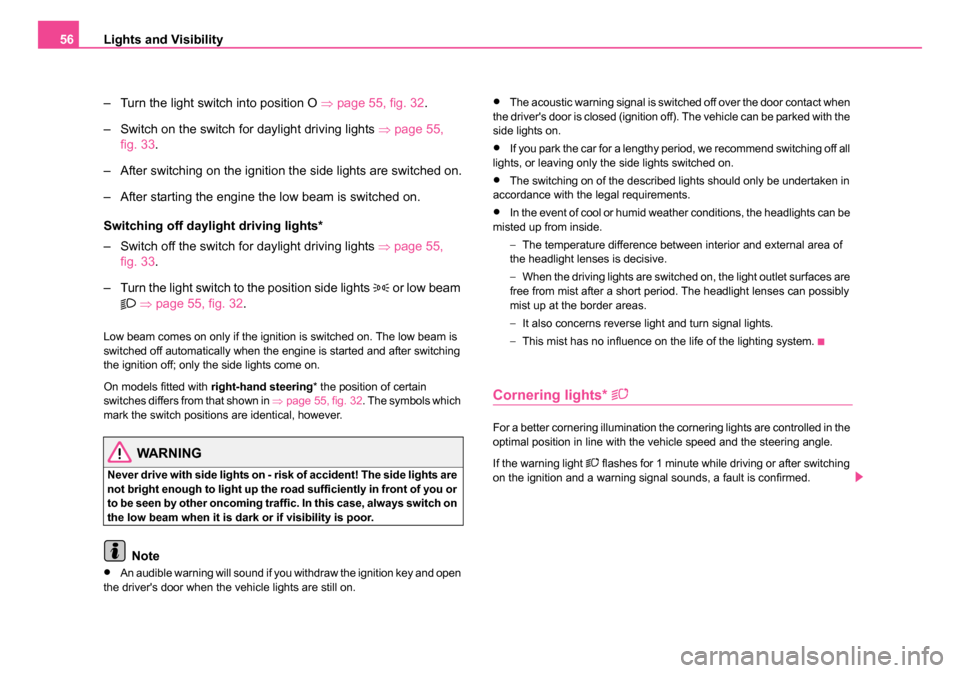2006 SKODA ROOMSTER ignition
[x] Cancel search: ignitionPage 45 of 274

Unlocking and locking
44
The doors can be opened from the inside if the vehicle is locked and the
safe securing system is deactivated:
•The door is unlocked by actuating the door-opening lever.
•The door opens upon actuating the door-opening lever again.
WARNING
If the vehicle is locked from the outside and the safe securing
system is activated, there must not be any person and animals in
the vehicle as it is then not possible to open either a door or a
window from the inside. The locked doors make it more difficult for
rescuers to get into the vehicle in an emergency - hazard!
Unlocking the vehicle using the key
– Turn the key in the lock of the driver's door to the left into the
opening position ⇒fig. 22 . – Pull on the door handle and open the door.
•All the doors are unlocked.
•The tailgate is then unlocked.
•The switched on interior lights come on over the door contact.
•The safe securing system is deactivated.
•The windows
are opened provided the key is held in the opening posi-
tion.
•The indicator light in the driver's door stops flashing if the vehicle is not
fitted with an anti-theft alarm system* ⇒page 49.
Note
If the vehicle is equipped with an anti-theft alarm system*, you must
unlock the vehicle by inserting the key into the driver door you then have
to insert the key into the ignition lock and switch the ignition on within 15
seconds after unlocking the door. The alarm will be triggered if you do
not switch on the ignition within 15 seconds.
Closing the vehicle with the key
– Turn the key in the lock of the driver door to the right into the
closing position ⇒fig. 22 .
•All the doors and the tailgate are locked.
•The switched on interior lights go out over the door contact.
•The windows are closed provided the key is held in the opening posi-
tion.
•The safe securing system is activated immediately.
•The indicator light in the driver door begins flashing.
Fig. 22 Turning the key
for unlocking and
locking the vehicle
AA
AB
NKO 20 A05.book Page 44 Wednesday, June 21, 2006 1:42 PM
Page 46 of 274

Unlocking and locking45
Using the systemSafetyDriving TipsGeneral MaintenanceBreakdown assistanceTechnical Data
Note
The opened driver door cannot be locked. It must be locked separately
after closing it.
Button for the central locking system*
If the vehicle was not locked from outside, it can be unlocked or
locked with the buttons and , also if the ignition is switched
off.
Locking all doors and the tailgate
– Press button ⇒fig. 23 . The symbol
in the button comes
on. Unlocking all doors and the tailgate
– Press button
⇒fig. 23 . The symbol
goes out in the
button.
The following applies if you have locked your vehicle using the button :
•It is not possible to open the doors or the tailgate from the outside
(safety feature, e.g. when stopping at traffic lights etc.).
•You can unlock the doors from the inside and open them by pulling the
door opening lever.
•If the driver door is opened, it cannot be locked, in order to avoid inad-
vertently being locked out of the vehicle You then have to lock a door
separately after closing it.
•In the event of an accident in which the airbags are deployed, the
locked doors are automatically unlocked from the inside in order to enable
rescuers to gain access to the vehicle.
WARNING
The central locking system also operates if the ignition is switched
off. All the doors and the tailgate are locked. Children should never
be left unattended in the vehicle since it is difficult to provide
assistance from the outside when the doors are locked. Locked
doors make it difficult for rescuers to get into the vehicle in an
emergency - hazard!
Note
•The door opening lever and the buttons for the central locking system
do not always operate if the safe securing system is activated.
Fig. 23 Central locking
switch
A1A2
A1
A2
A1
NKO 20 A05.book Page 45 Wednesday, June 21, 2006 1:42 PM
Page 49 of 274

Unlocking and locking
48
Remote control*
Description
You can use the remote control:
•to unlock and lock the car,
•unlock the tailgate.
The transmitter with the battery is housed in the handle of the master key.
The receiver is located in the interior of the car. The operating range of the
remote control is 10 metres but this range can be reduced if the batteries
are weak.
The master key has a fold-open key bit which can be used for unlocking
and locking the car manually and also for starting the engine.
If a lost key is replaced or if the receiver unit has been repaired or a new
unit installed, it is then necessary for a Škoda Service Partner to initialise
the system. Only after this is it possible to again use the remote control.
Note
•The remote control is automatically deactivated when the ignition is
switched on.
•The operation of the remote control may temporarily be affected by
interference from transmitters close to the car and which operate in the
same frequency range (e.g. mobile phone, TV transmitter).
•The battery must be replaced if the central locking or anti-theft alarm
system does react to the remote control at less than 3 metres away. We
recommend having the battery replaced by a Škoda Service Partner.
Unlocking and locking car
The radio-operated key differs according to the equipment
installed on the vehicle.
Unlocking th e vehicle
– Press button for about 1 second.
Locking the vehicle
– Press button for about 1 second.
Deactivating safe securing system
– Press button twice in 2 seconds. Further information ⇒page 42.
Tailgate release
– Press button for about 1 second ⇒fig. 27 .
Fig. 27 Radio-oper-
ated key
A1
A2
A2
A4
NKO 20 A05.book Page 48 Wednesday, June 21, 2006 1:42 PM
Page 50 of 274

Unlocking and locking49
Using the systemSafetyDriving TipsGeneral MaintenanceBreakdown assistanceTechnical Data
Folding out of the key
– Press button .
Folding up of the key
– Press button and collapse the key bit in the housing.
The turn signal lights flash twice as confirmation that the vehicle has been
unlocked. The vehicle will lock again automatically if you unlock the
vehicle using button but do not open a door or the tailgate within the
next 30 seconds. This function is intended to prevent the car being
unlocked unintentionally.
The safe securing system along with the anti-theft alarm system* are,
however, deactivated during these 30 seconds.
When the vehicle is unlocked or locked, the interior lights in the door
contact are automatically switched on or off.
The turn signal lights flash once to confirm that the vehicle has been
correctly locked.
If the turn signal lights do not flash, check the doors, bonnet and tailgate
again to ensure that they are closed. If the doors, the bonnet or the tailgate
remain open when the anti-theft alarm system* is activated, the turn signal
lights do not flash until after they have been closed.
WARNING
If the vehicle is locked from the outside and the safe securing
system is activated, there must not be any person in the vehicle as
it is then not possible to open either a door or a window from the
inside. The locked doors make it more difficult for rescuers to get
into the vehicle in an emergency - hazard!
Note
•Operate the radio remote control only when the doors and tailgate are
closed and you have visual contact with the vehicle.
•Once in the car, you must not press the lock button of the master key
before inserting the key into the ignition lock in order to avoid the car being
inadvertently locked and, in addition, the anti-theft alarm system* being
switched on. Should this happen, press the unlock button
of the master
key.
Synchonisation of the remote control
If the vehicle cannot be unlocked by actuating the remote control system
then it is possible that the code in the key and the control unit in the vehicle
are no longer synchronised. This can occur when the buttons on the radio-
operated key are actuated a number of times outside of the operative
range of the equipment or the battery on the remote control was replaced.
This means it is necessary to synchronise the code as follows:
•Press any button on the remote control.
•pressing of the button means that the door will unlock with the key
within 1 minute.
Anti-theft alarm system*
The anti-theft alarm system increases the level of protection against
people seeking to break into the vehicle. The system triggers audible and
visual warning signals if an attempt is made to break into the vehicle.
A3
A3
A1
NKO 20 A05.book Page 49 Wednesday, June 21, 2006 1:42 PM
Page 51 of 274

Unlocking and locking
50
How is the alarm system switched on?
The anti-theft alarm system is activated automatically when the vehicle is
locked with the key on the closed driver's door or by using the remote
control. It is activated 30 seconds after closing the door.
How is the alarm system switched off?
The anti-theft alarm system is switched off if the vehicle is unlocked by
only using the remote control. The vehicle is automatically locked again if
the vehicle is not opened within 30 seconds after reactivating the anti-theft
alarm system.
Once you unlock the vehicle by inserting the key into the driver door you
then have to insert the key into the ignition lock and switch the ignition on
within 15 seconds after unlocking the door in order to deactivate the anti-
theft alarm system. The alarm will be triggered if you do not switch on
the ignition within 15 seconds.
When is the alarm triggered?
The following security areas of the locked vehicle are monitored:
•Bonnet,
•Ta i l g a t e ,
•Doors,
•Ignition lock,
•Vehicle interior* ⇒page 50,
•Angle of the vehicle*,
•A drop in voltage of the on-board power supply.
An alarm is immediately triggered if either of the two battery terminals is
disconnected while the anti-theft alarm system is activated.
How is the alarm switched off?
You switch the alarm off if you unlock the car with the radio remote control
in the key or if you switch the ignition on.
Note
•The working life of the alarm siren is 5 years. More detailed information
is available from your Škoda Service Partner.
•Before leaving the car, check that all the windows and doors are prop-
erly closed in order to ensure that the anti-theft alarm system is fully oper-
ational.
•Coding of the radio remote control and the receptor part precludes the
use of the radio remote control from other vehicles.
Interior monitor* and Towing
protection*
The interior monitor and the towing protection detect
movements inside the vehicle interior and then trigger the
alarm.
Fig. 28 Interior
monitor pushbutton
NKO 20 A05.book Page 50 Wednesday, June 21, 2006 1:42 PM
Page 52 of 274

Unlocking and locking51
Using the systemSafetyDriving TipsGeneral MaintenanceBreakdown assistanceTechnical Data
The interior monitor and the towing protection are operated with
the button
. You can switch the interior monitor and the towing
protection off if there is a possibility that movements from (e.g.
children or animals) inside the vehicle interior or if the vehicle
must be transported (e.g. by train or ship) or towed, might trigger
the alarm.
Switch off the interior monitor and towing protection
– Switch off the ignition.
– Press the button
on the driver door ⇒page 50, fig. 28 .
– Lock the vehicle within 30 seconds. The interior monitor and the towing protection are switched off.
The interior monitor and the towing protection are switched on again auto-
matically the next time the car is locked.
Note
•You can also switch off the interior monitor and the towing protection,
by deactivating the safe securing system ⇒page 43.
•When the ignition key is removed or a door is opened, the symbol in
the button lights up red.
•Lighting up of the symbol in the button does not confirm that the interior
monitor and the towing protection are switched on.
Power windows*
Switch for power windows
Fig. 29 Buttons on the
driver's door
Fig. 30 Switch in the
rear door
NKO 20 A05.book Page 51 Wednesday, June 21, 2006 1:42 PM
Page 53 of 274

Unlocking and locking
52
The power windows operate only when ignition is switched on.
Opening a window
– A window is opened by pressing lightly on the respective button in the door. The process stops when one releases the
button.
– Additionally you can open the window automatically (fully opened) by pressing the button up to the stop. Renewed
pressing of the button causes the window to stop immediately.
Closing a window
– A window is closed through pulling lightly on the respective button in the door. The closing process stops when one
releases the button.
– Additionally you can close the window automatically (fully closed) by pulling the button up to the stop. Renewed pulling
of the button causes the window to stop immediately.
The switches for the individual windows are located in the operating part
in the driver's door ⇒page 51, fig. 29 , front passenger door and in the
rear doors*.
If the buttons for the rear doors are deactivated, the indicator light
in
the safety switch lights up.
The switch for the power window in the operating part in the driver's
door
Button for the power window in the driver's door
Button for the power window in the front passenger's door
Button for the power window in the rear door on the right* Button for the power window in the rear door on the left*
Safety pushbutton*
Safety pushbutton*
You can deactivate the switches for power windows at rear doors by
pressing the safety pushbutton ⇒page 51, fig. 29 . The buttons for
power windows at rear doors are activated again by pressing the safety
pushbutton again.
WARNING
•If you lock the vehicle from the outside, do not leave any person
in the vehicle since it is no longer possible to open the windows
from the inside in an emergency.
•The system is fitted with a force limiter. The closing process will
be stop if an obstruction is detected and the window will open
again. You should then take particular care when closing the
windows! You may otherwise suffer severe injuries as a result of
getting an arm, for example, jammed in the window!
•It is recommended to deactivate the electrically operated power
windows in the rear doors (safety pushbutton) ⇒page 51,
fig. 29 when children are being transported on the rear seats.
•In the event of a freezing up of the windscreen, first of all elimi-
nate the ice ⇒page 200 and then operate the power windows
otherwise the power window mechanism could be damaged.
Note
•After switching the ignition off, it is still possible to open or close the
windows for a further 10 minutes. The automatic closing and opening
functions will not operate during this time. The power windows are
switched off completely once you open the driver or front passenger door.
•When driving, use the existing heating, air conditioning and ventilation
system for ventilating the interior of the vehicle. If the windows are
AS
AA
AB
AC
AD
AS
AS
AS
AS
NKO 20 A05.book Page 52 Wednesday, June 21, 2006 1:42 PM
Page 57 of 274

Lights and Visibility
56
– Turn the light switch into position O ⇒page 55, fig. 32 .
– Switch on the switch for daylight driving lights ⇒page 55,
fig. 33 .
– After switching on the ignition the side lights are switched on.
– After starting the engine the low beam is switched on.
Switching off daylight driving lights*
– Switch off the switch for daylight driving lights ⇒page 55,
fig. 33 .
– Turn the light switch to the position side lights
or low beam
⇒ page 55, fig. 32 .
Low beam comes on only if the ignition is switched on. The low beam is
switched off automatically when the engine is started and after switching
the ignition off; only the side lights come on.
On models fitted with right-hand steering* the position of certain
switches differs from that shown in ⇒page 55, fig. 32 . The symbols which
mark the switch positions are identical, however.
WARNING
Never drive with side lights on - risk of accident! The side lights are
not bright enough to light up the road sufficiently in front of you or
to be seen by other oncoming traffic. In this case, always switch on
the low beam when it is dark or if visibility is poor.
Note
•An audible warning will sound if you withdraw the ignition key and open
the driver's door when the vehicle lights are still on.
•The acoustic warning signal is switched off over the door contact when
the driver's door is closed (ignition off). The vehicle can be parked with the
side lights on.
•If you park the car for a lengthy period, we recommend switching off all
lights, or leaving only the side lights switched on.
•The switching on of the described lights should only be undertaken in
accordance with the legal requirements.
•In the event of cool or humid weather conditions, the headlights can be
misted up from inside.
−The temperature difference between interior and external area of
the headlight lenses is decisive.
− When the driving lights are switched on, the light outlet surfaces are
free from mist after a short period. The headlight lenses can possibly
mist up at the border areas.
− It also concerns reverse light and turn signal lights.
− This mist has no influence on the life of the lighting system.
Cornering lights*
For a better cornering illumination the cornering lights are controlled in the
optimal position in line with the vehicle speed and the steering angle.
If the warning light
flashes for 1 minute while driving or after switching
on the ignition and a warning signal sounds, a fault is confirmed.
NKO 20 A05.book Page 56 Wednesday, June 21, 2006 1:42 PM